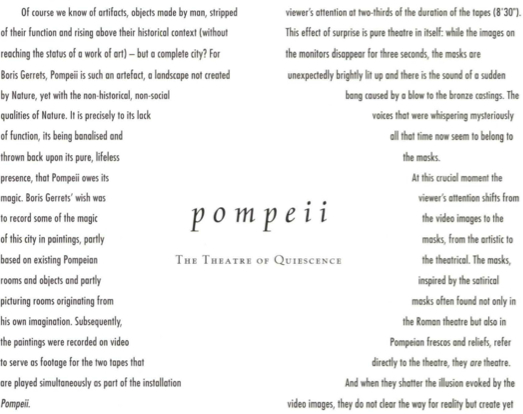It is an enigma that reason cannot solve. That everything is still there - the street, the houses, the frescos - and that everything can be touched and felt, although it escapes your mental powers, because between you and these things lies a yawning gap of two thousand years: that is the enigma of Pompeii. Here, time has stood still for centuries. One catastrophal moment perpetuated, the petrifaction of time itself turns into an object of interest. Seeing Pompeii means finding yourself in a vacuum of time and spoce formed by catastrophe.
Of course we know of artifacts, objects made by man, stripped of their function and rising above their historical context (without reaching the status of a work of art) - but a complete city? For Boris Gerrets, Pompeii is such an artefact, a landscape not created by Nature, yet with the non-historical, non-social qualities of Nature. It is precisely to its lack of function, its being banalised and thrown back upon its pure, lifeless presence, that Pompeii owes its magic. Boris Gerrets' wish was to record some of the magic of this city in paintings, partly
based on existing Pompeian rooms and objects and partly picturing rooms originating from his own imagination. Subsequently, the paintings were recorded on video to serve as footage for the two tapes that are played simultaneously as part of the installation Pompeii.
Originally, both tapes were meant for Circumstantial Evidence, a stage play performed by the dance group Cloud Chamber in 1986 (Boris Gerrets is one of the founders of this group).
The idea was to present a random picture of everyday reality, allowing you to distance yourself from your own situation in such a way that you could oversee that situation as it were from the outside, as an astral body. Pompeii was pre-eminently suitable as a metaphor for such a rise above reality. The setting consisted of a lobby and a number of hotel rooms. In each room an actor could be observed, engaged in private matters. The tapes, shown on television sets placed in the lobby and in each of the rooms, then functioned as a point of rest in the performance, a vacuum in the play. In the theatre, everything is meaning. Everything is full of meaning in the sense that you ore forced to interpret os soon as something is said. Everything is linked together. In the theatre, it is very difficult to do something meaningless. Not that video is without meaning, that the images have no meaning, but at least they are left in peace.
The context in which the tapes are shown in the installation is totally different. In the darkened room there are two monitors showing the paintings. In the same room, outside the viewer's field of vision, two bronze masks are hanging which suddenly attract the viewer's attention at two-thirds of the duration of the tapes (8’30“). This effect of surprise is pure theatre in itself: while the images on the monitors disappear for three seconds, the masks are unexpectedly brightly lit up and there is the sound of a sudden bang caused by a blow to the bronze castings. The voices that were whispering mysteriously all that time now seem to belong to the masks.
At this crucial moment the viewer's attention shifts from the video images to the masks, from the artistic to the theatrical. The masks, inspired by the satirical masks often found not only in the Roman theatre but also in Pompeian frescos and reliefs, refer directly to the theatre, they are theatre. And when they shatter the illusion evoked by the video images, they do not clear the way for reality but create yet another illusion, that of drama and tragedy.
The essence of Pompeii lies in the conflict between the video images and the masks and the way in which each deals with the Pompeii theme. The video images (the paintings) show the standing still of time and space, the perpetuation of a catastrophal moment. That is an 'aesthetical' sensation. The masks, however, show the drama of that standing still, the impenetrable, divine motives that led to the catastrophe. It will be clear why Pompeii, if only in the emblematical form of a mask, has so much in common with theatre: both reflect something of the fate of mankind. In Gerrets' words: To regard human life from its fatal destiny, that is the essence of the theatre. Which leads us to the 'tragic' sensation.
Mediamatic Magazine vol 5#1+2 1 Jan 1990
Pompeii
The Artists
The Theatre of Quiescence
